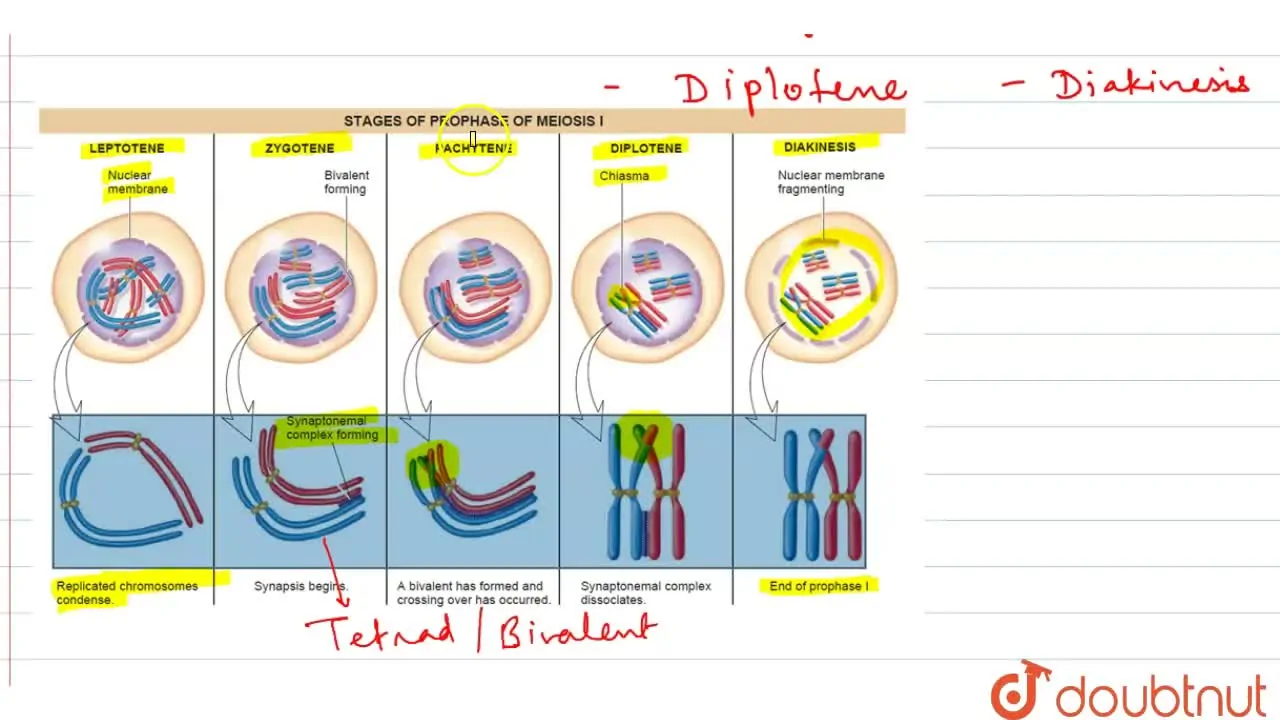Describe various subphases of prophase - I of Meiosis - I. Solution in Gujrati
Prophase. I of Meiosis - I : It is longer and more complex. It has been sub divided into five sub phases based on chromosomal behaviour.

(i) Leptotene : This is a first phase of meiosis. During this phase the chromosomes become gradually visible. The compaction of hromosomes continues throughout Leptotene.
Each chromosome is made up of two chromatids and centromere attached to them. But chromatids are tangled with each other so its dual form is not seen.
(ii) Zygotene : During this stage, chromosomes start pairing together and this process of association is called Synapsis. Such paired chromosomes are called homologous chromosomes.
This process proceeds further like a Zipper. Signal strands of chromosomes entangled or interwind around each other at some places. The complex formed by a pair of synapsed homologous chromosomes is called a Bivalent. Infact it is a tetrads.
(iii) Pachytene : During this stage bivalent chromosomes clearly appears as tetrads. Single chromatid of the homologous chromosomes are entangled with each other.
This stage is characterised by the appearance of recombination nodules.
Crossing over occurs between non-sister chromatids of the homologous chromosomes.
Crossing over is the exchange of genetic material between two homologous chromosomes.
Crossing over is also an enzyme-mediated process and the enzyme involved is called recombinase.
Crossing over leads to recombination of genetic material on the two chromosomes.
Crossing over takes place at the exchange place of genes. This way new combinations are formed.
(iv) Diplotene : The beginning of diplotene is recognized by the dissolution of the synaptonemal complex and the tendency of the recombined homologous chromosomes of the bivalents to separate from each other except at the sites of crossing over.
These X-shaped structures are called Chiasmata.
The number of Chiasmata depend on length of chromosomes. They are more in long chromosomes. Exchange of genes takes place at site of formation of chiasmata.
(v) Diakinesis : Bispindle fibre separating homologous chromosomes is formed, single chromatids are separated at the site of formation of chiasmata.
By the end of diakinesis, the nucleolus disappears and the nuclear envelope also breaks down. Each chromosome is made up of two single chromatids and centromere attaching to it
Related Playlists
- BOOK - KUMAR PRAKASHANCHAPTER - CELL CYCLE AND CELL DIVISION EXERCISE - SECTION - A (Exam Oriented Questions - Answers From Darpan) (Significance of Meiosis)1videos
CELL CYCLE AND CELL DIVISION
- BOOK - KUMAR PRAKASHANCHAPTER - CELL CYCLE AND CELL DIVISION EXERCISE - SECTION - B (Difference /Scientific Reasons) (Give differences : ( 2 Marks))4videos
CELL CYCLE AND CELL DIVISION
- BOOK - KUMAR PRAKASHANCHAPTER - CELL CYCLE AND CELL DIVISION EXERCISE - SECTION - A (Exam Oriented Questions - Answers From Darpan) ( Significance of Mitosis)1videos
CELL CYCLE AND CELL DIVISION
- BOOK - KUMAR PRAKASHANCHAPTER - CELL : THE UNIT OF LIFEEXERCISE - Questions from Module (Question Paper)(Describe in detail:)1videos
CELL : THE UNIT OF LIFE
- BOOK - KUMAR PRAKASHANCHAPTER - CHEMICAL COORDINATION AND INTEGRATION EXERCISE - Objective Section (Fill in the blanks)9videos
CHEMICAL COORDINATION AND INTEGRATION
Similar Questions
Explain importance of meiosis.
04:14View SolutionKaryokinesis and Cytokinesis .
20:05View SolutionExplain importance of Mitosis.
02:53View SolutionDescribe types of chromosomes with diagram.
02:14View SolutionHormones produce their effects on target tissues by binding to specific proteins called……….
View SolutionHomologous pairing in prophase I of meiosis I is called
03:12View Solution9. Cell Division - Meiosis I -Prophase I
02:59View SolutionThe correct sequence of prophase–I of meiosis is :–
01:16:25View SolutionWhat are the different subphases of prophase 1?
07:14View SolutionWhy meiosis is called reductional division? Describe the key events of prophase-I of meiosis-I cell division. Write the significance of meiosis cell division.
06:16View SolutionDescribe the various stages of prophase I of meiosis I.
02:53View SolutionThe subphase of prophase-I showing enlargement of nucleus and nucleolus respectively are
39:46View SolutionMEIOSIS- PROPHASE I
32:00View SolutionDescribe Prophase-I of Meiosis-I with suitable diagrams.
06:03View SolutionHow is prophase I of meiosis I different from prophase of Mitosis?
View Solution


